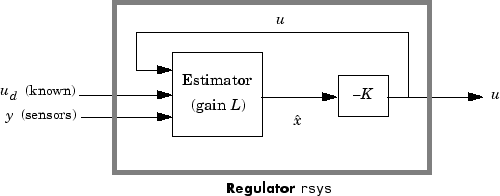reg
Form regulator given state-feedback and estimator gains
Syntax
rsys = reg(sys,K,L)
rsys = reg(sys,K,L,sensors,known,controls)
Description
rsys = reg(sys,K,L) forms
a dynamic regulator or compensator rsys given a
state-space model sys of the plant, a state-feedback
gain matrix K, and an estimator gain matrix L.
The gains K and L are typically
designed using pole placement or LQG techniques. The function reg handles
both continuous- and discrete-time cases.
This syntax assumes that all inputs of sys are
controls, and all outputs are measured. The regulator rsys is
obtained by connecting the state-feedback law u =
–Kx and the state estimator with gain matrix L (see estim).
For a plant with equations
this yields the regulator
This regulator should be connected to the plant using positive feedback.

rsys = reg(sys,K,L,sensors,known,controls)
handles more general regulation problems where:
The plant inputs consist of controls u, known inputs ud, and stochastic inputs w.
Only a subset y of the plant outputs is measured.
The index vectors sensors, known,
and controls specify y, ud,
and u as subsets of the outputs and inputs of sys.
The resulting regulator uses [ud ; y]
as inputs to generate the commands u (see next
figure).

Examples
Given a continuous-time state-space model
sys = ss(A,B,C,D)
with seven outputs and four inputs, suppose you have designed:
A state-feedback controller gain
Kusing inputs 1, 2, and 4 of the plant as control inputsA state estimator with gain
Lusing outputs 4, 7, and 1 of the plant as sensors, and input 3 of the plant as an additional known input
You can then connect the controller and estimator and form the complete regulation system by
controls = [1,2,4]; sensors = [4,7,1]; known = [3]; regulator = reg(sys,K,L,sensors,known,controls)
Version History
Introduced before R2006a